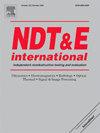基于自适应VMD和时空波场域的激光超声技术在高温条件下检测钛合金缺陷
IF 4.5
2区 材料科学
Q1 MATERIALS SCIENCE, CHARACTERIZATION & TESTING
引用次数: 0
摘要
钛合金以其优异的性能被广泛应用于航空航天等行业的关键结构部件。然而,高温环境下的损伤检测较为困难,超声信号的信噪比也明显较低。这对传统的无损检测方法准确识别和表征内部缺陷提出了严峻的挑战。本文提出了一种新的高温激光超声缺陷检测方案。自适应变分模态分解(VMD)方法在粒子群优化算法中引入置换熵作为适应度函数,识别最优的惩罚因子和模态分解次数,从而实现高温环境下超声信号的有效最优分解和降噪。此外,通过建立表面波振幅与表面缺陷深度以及内部缺陷直径的映射关系,实现了钛合金材料缺陷的定量识别与检测。结果表明,钛合金在800℃时的损伤特征得以实现。自适应vmd处理后的信号平均信噪比增强2.453 dB,最大幅度降低0.177%,平均波形相关系数为0.907,平均对准熵为0.693。本文提出的方法对时域信号处理和高温激光超声缺陷检测具有重要意义。本文章由计算机程序翻译,如有差异,请以英文原文为准。
Laser-ultrasonic technology based on adaptive VMD and spatio-temporal wave-field domains to detect defects in titanium alloys under high-temperature conditions
Titanium alloys are widely used in key structural components in aerospace and other industries, owing to their excellent performance. However, detecting damages in high-temperature environments is difficult, and the signal-to-noise ratio of ultrasonic signals is also significantly low. This poses a serious challenge for traditional non-destructive testing methods to accurately identify and characterize internal defects. In this work, a novel high-temperature laser-ultrasonic defect detection scheme is proposed. The adaptive variational mode decomposition (VMD) method introduces permutation entropy as the fitness function in the particle-swarm-optimization algorithm to identify the optimal penalty factor and number of modal decompositions, thereby achieving effective optimal decomposition and noise reduction of ultrasonic signals in high-temperature environments. Furthermore, by establishing a mapping relationship between the surface wave amplitude and surface defect depth, as well as the internal defect diameter, quantitative identification and detection of defects in titanium alloy materials is achieved. The results show that damage characterization of the titanium alloy is realized at 800 °C. The adaptive-VMD processed signal exhibits an average signal-to-noise ratio enhancement of 2.453 dB, maximum magnitude reduction of 0.177 %, average waveform correlation coefficient of 0.907, and average alignment entropy of 0.693. The method proposed in this paper has significant implications for time-domain signal processing and high-temperature laser ultrasonic defect detection.
求助全文
通过发布文献求助,成功后即可免费获取论文全文。
去求助
来源期刊

Ndt & E International
工程技术-材料科学:表征与测试
CiteScore
7.20
自引率
9.50%
发文量
121
审稿时长
55 days
期刊介绍:
NDT&E international publishes peer-reviewed results of original research and development in all categories of the fields of nondestructive testing and evaluation including ultrasonics, electromagnetics, radiography, optical and thermal methods. In addition to traditional NDE topics, the emerging technology area of inspection of civil structures and materials is also emphasized. The journal publishes original papers on research and development of new inspection techniques and methods, as well as on novel and innovative applications of established methods. Papers on NDE sensors and their applications both for inspection and process control, as well as papers describing novel NDE systems for structural health monitoring and their performance in industrial settings are also considered. Other regular features include international news, new equipment and a calendar of forthcoming worldwide meetings. This journal is listed in Current Contents.
 求助内容:
求助内容: 应助结果提醒方式:
应助结果提醒方式:


